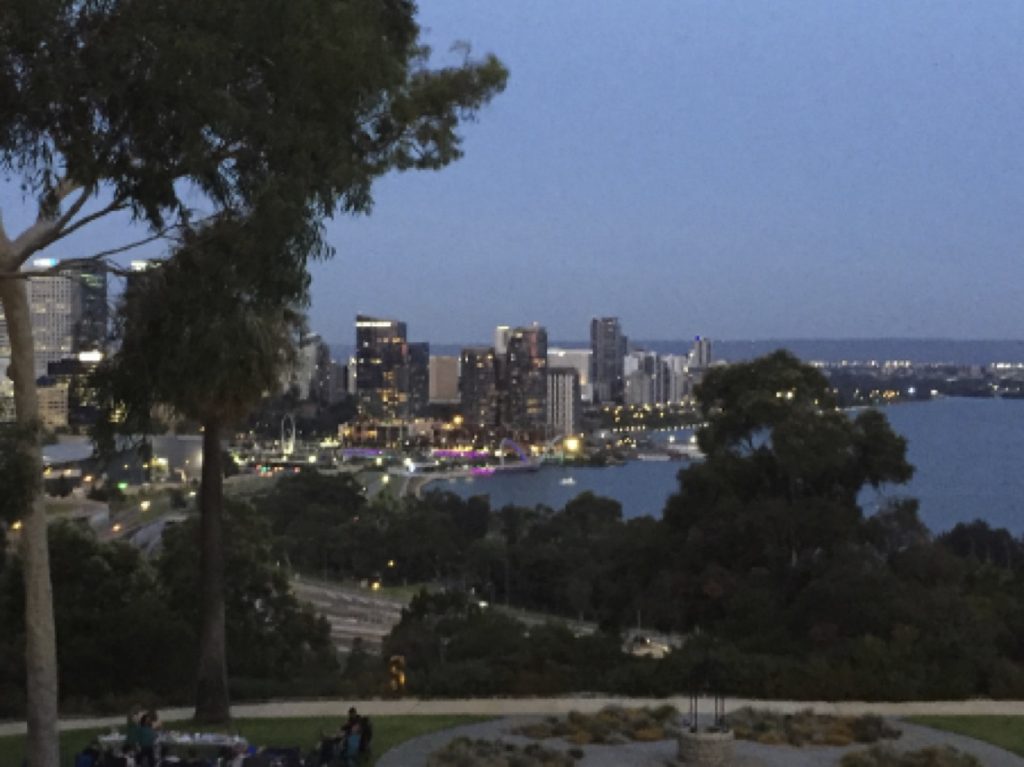by Kim Reid
I’m writing this on the plane back to Melbourne from AMOS2020 in Fremantle, Perth. I think it was a successful conference for me. I define a successful conference or workshop based on how many leads I have to follow up when I get home, whether that’s papers or datasets to read about, people to email, meetings to arrange, new tools to learn, methods to try etc.
When I get back to work I have least one dataset to explore, PerilAus, a record of disasters in Australia since 1900 where impacts are defined based on socio-economic outcomes rather than just percentiles or rainfall amounts. I met new people particularly from outside of universities who reminded me that our research can impact decisions and policies in the world outside universities namely the agriculture and energy sectors. I got the inside scoop on back trajectory models, which I’m hoping to look into when I return, and contacts for when I inevitably get stuck and need some advice. I learnt that hydrological sensitivity initially decreases with rising temperatures before increasing. I learnt that I should use SST indices rather than the SOI when looking at relationships between rainfall and only ENSO since Darwin is affected by Indian Ocean winds as well as winds from the Pacific. I learnt that rainfall event duration is increasing in northern Australia but decreasing in the south. I learnt that Matlab has a track clustering toolbox, and I should probably bite the bullet and learn Python. I learnt that Rottnest means rat nest because early explorers thought quokkas were rats (thanks, Todd) and dolphins swim in Fremantle beaches at sunset.
I also had two panic attacks.
About one in five Australian university students have a mental illness. This is higher than the staff at universities (about one in eight) and significantly higher than the general population.
According to a study on psychological distress in Australian university students, predictors included: studying full-time, financial stress, being aged between 18 and 34, being female and not being in first year. Pressure, competition and stress are key drivers of graduate student mental health problems.


Academia has the tendency to glorify overworking and long hours, plus students often find it difficult to take time off and step away from a long term research project, especially knowing their candidature clock still ticks while they’re on holidays.
Agoraphobia is a favourite of Hollywood’s and therefore often terribly misrepresented in pop culture. Agoraphobics in movies are often recluses with their key characteristic being that they are afraid to leave their house. In reality, agoraphobia is the fear of having a panic attack and not being able to ‘escape’ which therefore often leads you to have a panic attack.
I call it the fear of fear and it’s self-perpetuating. In fight-or-flight mode, our amygdala tells our hypothalamus we’re in danger and it needs to prepare our body to attack or run away. Our hypothalamus signals to our pituitary gland to release adrenaline and cortisol (the stress hormone). These hormones boost our energy and make us hyper-focused on any danger nearby. Our heart and breathing rates skyrocket. By the time this process occurs, our conscious mind has probably only just realised there is a threat. The fight or flight mechanism is incredibly important for our survival (pdf).
But, sometimes the amygdala is too trigger happy. Like a smoke alarm beeping every time someone burns the toast, the amygdala sets off the body’s fight-or-flight response when there is no fire. Agoraphobia means I go into flight-or-fight mode on aeroplanes, trains, cars, trams, crowded places, restaurants, bars, long corridors, shopping centres – you get the idea.
Despite taking medication and going through counselling, sometimes the panic attacks still happen. I’m sharing this because I want to normalise these discussions. This is so those who don’t experience anxiety or depression can understand why someone like me may randomly walk outside in the middle of a presentation or other strange behaviours we do to help lower our heart rates. I also write it so those with mental health disorders know it’s possible to suffer from these conditions but still go to conferences.
How to help yourself have a successful conference:
- If there is someone you want to talk to, especially someone senior, send them an email and arrange a time, even if it’s as vague as ‘I’ll catch you at afternoon tea on this day’. It saves you needing to sidle into a group of people you don’t know and interrupting their conversation.
- It’s okay to not go to any sessions (not too often of course). Conference days are full-on. They are exhausting for everyone, extra exhausting if you are introverted, and extra-extra exhausting if you have a mental illness too. Taking 15 minutes to catch your breath, go to the loo, grab some fresh air and have some water is more valuable than sitting in a talk and not paying attention.
- Stand at the back or sit on the edge of a row. Okay, I know this is maladaptive – an adaptive technique that reinforces the need for adaption in the first place, like building more air conditioners to dealing with global warming – but having an easy ‘escape route’ can help reduce anxious feelings.
- Don’t forget to eat food and drink water.
How to help other people have a successful conference:
- If you think the speaker has got something wrong or misunderstood something, tell them privately not during question time in front of an audience. The best way to deliver criticism is to also compliment what they did well at the same time.
- If you think someone is doing a good job – tell them. Your comment could make someone’s whole conference.
- Invite people to lunch/dinner who you may not normally invite especially if they are standing alone.
- Don’t question people’s decisions to go to bed early, not drink alcohol or avoid certain foods.
